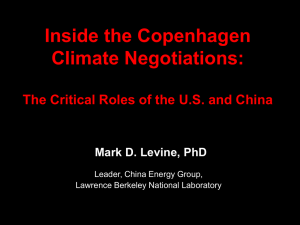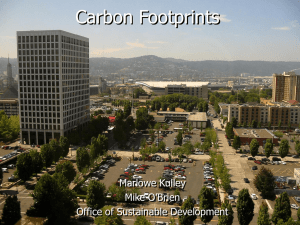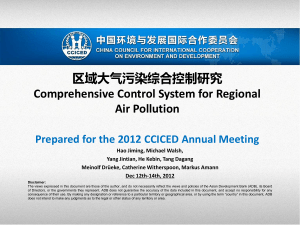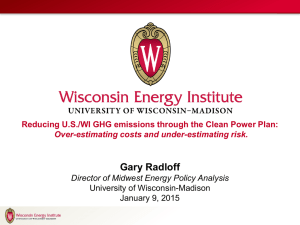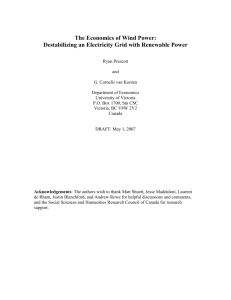A summary and update
advertisement
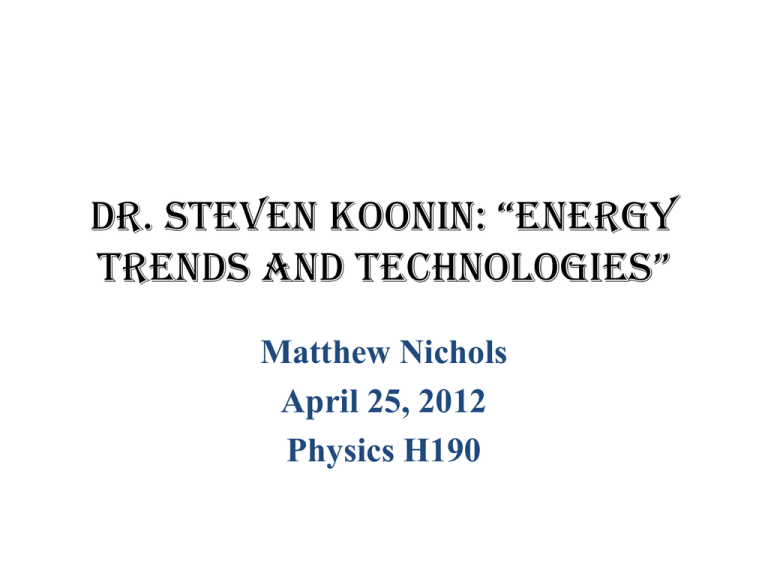
Dr. Steven Koonin: “EnErgy TrEnds and TEchnologiEs” Matthew Nichols April 25, 2012 Physics H190 The Mysterious Steven Koonin • Born in Brooklyn, NY • B.S. in physics from Caltech (1972) • PhD in theoretical physics from MIT (1975) • Professor at Caltech (1975-2004) • Studied theoretical nuclear many body physics and computational physics • Was chief scientist at BP: responsible for BPs long range technology plans Energy Trends and Technologies • It’s not just about new technology • Energy so pervasive in society that several factors must be considered including the economics, politics, and cultural context • Once these factors are considered, then one can talk about the technology Drivers of the Energy Future • GDP & pop. growth • urbanization Demand Growth Supply Challenges • Significant resources • Non-conventionals Technology and policy • Local pollution • Climate change Environmental Impacts Security of Supply • Dislocation of resources • Import dependence Growth in Energy Demand Due to Economic Activity 400 US Primary Energy per capita (GJ) 350 300 Australia 250 Russia France 200 S. Korea 150 100 Malaysia 50 China 0 India 0 Mexico Japan UK Ireland Greece Brazil 5,000 10,000 15,000 20,000 25,000 GDP per capita (PPP, $2000) 30,000 35,000 40,000 Energy Demand Breakdown vs. Time BNBOE=Billion Barrels of Oil 130 Equivalent Global Energy Demand Growth by Sector (1971-2030) 120 110 100 90 Energy Demand (bnboe) 80 70 60 50 40 30 20 10 1 BNBOE = 6.11x1018 Joules 0 1971 Key: 2002 - transport Notes: 1. Power includes heat generated at power plants 2. Other sectors includes residential, agricultural and service - power 2030 - industry - other sectors Source: IEA WEO 2004 Energy Supply • There are significant resources in the ground • The world is not running out of energy any time soon • However, a rise in unconventional sources of energy is expected Sources of Energy in the US since 1850 100% 90% 80% Renewables Nuclear Gas Oil Hydro Coal Wood 70% 60% 50% 40% 30% 20% 10% 0% 1850 1880 1910 1940 1970 2000 Source: EIA Sources of Energy: Global Scale 50% Nuclear Hydro 6.3% 6.0% 40% 36.4% Coal Oil 45% Oil 35% Coal 30% 27.8% 25% Gas 20% 23.5% Natural gas 15% 10% 5% 0% Hydro Nuclear 1970 1975 1980 1985 1990 1995 2000 2005 Projection of Primary Energy Sources ’04 – ’30 Annual Growth Rate (%) M toe 18,000 16,000 14,000 12,000 10,000 Other Renew ables 6.5 Biomass & w aste 1.3 Hydro 2.0 Nuclear 0.7 Gas 2.0 Oil 1.3 Coal 1.8 8,000 6,000 4,000 2,000 0 1980 2004 2010 2015 2030 Note: ‘Other renewables’ include geothermal, solar, wind, tide and wave energy for electricity generation Source: IEA World Energy Outlook 2006 (Reference Case) Fossil Fuel Supply 6,000 Yet to Find Reserves & Resources (bnboe) 5,000 4,000 3,000 Unconventional Unconventional R/P Ratio 164 yrs. 2,000 1,000 R/P Ratio 67 yrs. R/P Ratio 41 yrs. 0 Oil Source: World Energy Assessment 2001, HIS, WoodMackenzie, BP Stat Review 2005, BP estimates Gas Coal How Much Oil is Available and at What Price? Availability of oil resources as a function of economic price Source: IEA (2005) Security of Supply • There is a dislocation of resources around the globe: the oil and gas are in the ground not where the main consumers of the product are • Thus the dislocation leads to necessary trade, and a reliance by the consuming countries on the stability and security of distant oil/gas sources Dislocation of Fossil Fuel Sources from their Consumers 3 Largets Energy M arkets (N.America + Europe + Asia Pacific) ROW 12% 22% 35% 39% 85% 90% 88% 78% 65% 61% 15% 10% Consumption Reserves OIL Source: BP Statistical Review 2006 Consumption GAS Reserves Consumption Reserves COAL ROW = Rest of World Conclusions about Energy Supply Dislocation • The oil is where the people ARE NOT and the coal is where the people ARE • As countries become increasingly concerned about supply issues, they will turn increasingly to coal (e.g. China and partially the U.S.) Environmental Impacts: Local Pollution and Climate Change • Local pollution is not so problematic: the technology exists and is available at cost • He gives LA as an example, how the local pollution has improved over the past few years • As countries/governments get more concerned they will be more willing to invest in the available technology to remove the local pollution. • Climate change is more problematic • Evidence implies CO2 concentration is rising due to fossil fuel use (concentration increases by ~2 PPM a year) • Many say that 2X the pre industrial level of CO2 (550 ppm) is a widely discussed stabilization target (beyond which it will exert a dangerous influence on the climate system Things to Know About CO2 In the Atmosphere in Order to Solve Problem Emissions • • • • • Concentration The lifetime of CO2 in the atmosphere is about 1000 years About half of what we put up there stays up there A bend in the emissions graph will just delay the time that we cross the dangerous CO2 level threshold Rule of thumb: every 10 percent reduction in emissions buys you about 7 years before reaching the max We need to reduce emissions by a factor of two from current levels to remain stable at the 550 ppm level, and this in the face of doubling the demand of energy by the middle of the century, so we need to cut the common intensity of our energy system by a factor of four Social Barriers to Emission Reductions • • • • • Climate threat is intangible and diffuse; can be obscured by natural variability – It’s difficult to attribute things to climate change phenomena. It’s hard to make the climate change discussion real for people – contrast ozone, air pollution Energy is at the heart of economic activity CO2 timescales are poorly matched to the political process – Buildup and lifetime are centennial scale – Energy infrastructure takes decades to replace • Power plants being planned now will be emitting in 2050 • Autos last 20 years; buildings 100 years – Political cycle is ~6 years; news cycle ~1 day There will be inevitable distractions – a few years of cooling – economic downturns – unforeseen expenses (e.g., Iraq, tsunamis, …) Emissions, economics, and the priority of the threat vary greatly around the world Emissions Facts • 21st Century emissions from the Developing World (DW) will be more important than those from the Industrialized World (IW) – DW emissions growing at 2.8% vs. IW growing at 1.2% – DW will surpass IW during 2015 - 2025 DW E IW • • t Sobering facts – When DW ~ IW, each 10% reduction in IW emissions is compensated by < 4 years of DW growth – If China’s (or India’s) per capita emissions were those of Japan, global emissions would be 40% higher Reducing emissions is an enormous, complex challenge; technology development will play a central role Emissions By Source (2000) Note: land use means deforestation and the like. • Land use and agriculture are major contributors: there are large portions of the emissions spectrum that are unregulated and need work! Source: Stern Review, from data drawn from World Resources Institute Climate Analysis Indicators Tool (CAIT) on-line database version 3.0 Technologies and Policies • There are 4 aspects of energy technologies that make them different: 1) Scale: -Large infrastructure, amounts of material, and numbers of units (more cars will be built in the next 20 years than were built in the whole 20th century). -Requires large capital and leverage of existing infrastructure. -This is one reason way large companies should be involved in the innovation chain early on. 2) Ubiquity of energy: -There are many players with sometimes divergent interests (consumers, suppliers, governments, NGOs, etc…) 3) Longevity: -Lifetimes of large equipment and/or interoperability imply slow changes (e.g. BP can’t just change its fuel because it must work with older cars too) 4) Incumbency: -New energy technologies must compete in cost. -They may not provide any qualitatively new service to the end user Energy Technologies: Examples Primary Energy Sources: Extraction & Conversion Technologies: End Use Technologies: •Light Crude •Heavy Oil •Tar Sands •Wet gas •CBM •Tight gas •Nuclear •Coal •Solar •Wind •Biomass •Hydro •Geothermal •Exploration •Deeper water •Arctic •LNG •Refining •Differentiated fuels •Advantaged chemicals •Gasification •Syngas conversion •Power generation • Photovoltaics •Bio-enzyimatics •H2 production & distribution •CO2 capture & storage •ICEs •Adv. Batteries •Hybridisation •Fuel cells •Hydrogen storage •Gas turbines •Building efficiency •Urban infrastructure •Systems design • Other efficiency technologies •Appliances •Retail technologies There are no “silver bullets” • But some have a larger calibre than others ! We have about 30-40 years to deal with these problems so we have to find those technologies which will have the biggest impact at the lowest cost How Do We Assess Energy Technologies? • • Current technology status and plausible technical headroom: wind mills have been around for millennia, and there will be incremental improvements, but compare to other improvements in biological technologies Budgets: – Economic (cost relative to other options) – Energy (output how many times greater than input) – Emissions (pollution and CO2; operations and capital) • • • Materiality (at least 1TW = 5% of 2050 BAU energy demand: technology has to scale) Other costs - reliability, intermittency etc. Social and political acceptability we also must know what problem we are trying to solve! Problems to Solve • There are 2 problems that technology plays into 1) Concern over future availability/cost of oil and gas 2) Concern relating to threat of climate change • It’s really hard to beat liquid hydrocarbons • Gasoline has a lot more energy per unit mass than liquid H2 or compressed gas • With small weight and small space, liquid hydrocarbons are likely to stay around for a while • For liquid hydrocarbons, the real issue is where you get your carbon from Fossil So W oo y dp ulp W Ed he ib at le fa ts M ea /o ils t /P ou l tr y Bi Co om t as ton Bi om s as tod ay sp ot en tia l 200 Co rn Pa pe r 700 Ls Fuel NG as ol ine Di es el Na Coa tu l O ra th lg er as pe tro leu m G Annual US Carbon (Mt C) So Where Does the U.S. Get Its Carbon From? Agriculture Biomass 1000 600 500 400 300 15% of Transportation Fuels 100 0 Where Does the World Get Its Electricity From? (2004) Oil 6.67% Nuclear 15.74% Hydro 16.14% Biomass 1.30% Gas 19.60% Other 2.13% Wind 0.47% Geothermal 0.32% Coal 39.73% Source: IEA WEO 2006 Tidal/Wave 0.01% Solar 0.02% Electricity Cost vs. CO2 Cost 160 Conventional Coal 140 Solar PV ~$250 Cost of Electricity ($/MW-hr) 120 Area where options multiply 100 Natural Gas ($5/MMBTU) 80 CCS Onshore Wind 60 Nuclear 40 $0.35/gal or $0.09/litre 20 0 0 20 40 60 80 CO2 Cost ($/tonne) Source: IEA Technology Perspectives 2006, IEA WEO 2006 and BAH analysis Notes: 1) Add solar 2) $40/tonne CO2 cost or tax is $0.35/gallon of gasoline or $0.09 (or 5p)/litre 100 120 Efficiency vs. Conservation • Efficiency and conservation are NOT the same thing • Ex 1) when steam engines became more efficient, the amount of coal used did not decrease, but actually increased because people used it in more and different ways • Ex 2) supply limited situations: right now there is not enough electricity in china to meet the demand for air conditioning. If we make air conditioners more efficient we will keep more Chinese cool, but will not reduce the demand for energy because it is a supply limited situation • The surest way to induce conservation is to either increase the price or to enact some sort of policy. But either is politically difficult for a government to do and remain in power Likely 30 Year Energy Future • Hydrocarbons will continue to dominate transportation (high energy density) -conventional crude/heavy oils/CTL ensure continuity of supply at reasonable cost • Vehicle efficiency can be at least doubled (hybrids, plug in hybrids, HCCI, diesel) • In the power sector coal (security) and gas (cleanliness) will continue to dominate heat and power -nuclear energy (security,CO2) will be a fixed, if not growing, fraction of the mix -renewables will find some application but will remain a small fraction of the total -advanced solar a wildcard • Demand reduction will happen where economically effective or via policy • CO2 emissions (and concentrations) continue to rise absent dramatic global action Necessary Steps for the Technology • We need technically informed, coherent, and stable government policies -educated decision makers and an educated public • For short/mid term technologies, we should avoid winners/losers -a level playing field for all applicable technologies -emissions trading • For long term technologies, we need support for pre-competitive research like fission, PV, biofuels, etc… • Business needs reasonable expectation of carbon price • Universities/labs must recognize and act on importance of energy research (technology and policy) • Need business to get involved in this research in the next several decades since business like it or not is the way to get things done Acknowledgements • 2008 Regent’s Lecture: Steve Koonin “Energy Trends and Technologies” • http://www.youtube.com/watch?v=mu27nT3 ZTdQ • Georgia Tech Distinguished Lecture: Steve Koonin “Energy Trends and Technologies for the Coming Decades”



